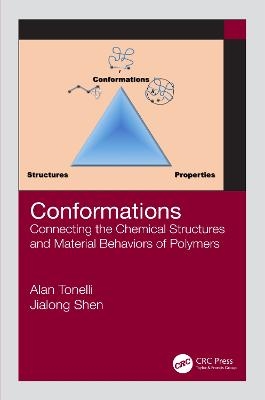
Conformations
CRC Press (Verlag)
978-1-138-57032-0 (ISBN)
The authors examine the connections between the microstructures of polymers and the rich variety of physical properties they evidence. Detailed polymer architectures, including the molecular bonding and geometries of backbone and side-chain groups, monomer stereo- and regiosequences, comonomer sequences, and branching, are explicitly considered in the analysis of the conformational characteristics of polymers.
This valuable reference provides practicing materials engineers as well as polymer and materials science students a means of understanding the differences in behaviors and properties of materials made from chemically distinct polymers. This knowledge can assist the reader design polymers with chemical structures that lead to their desired material behaviors and properties.
Alan Tonelli, born in Chicago in 1942, received a BS in Chemical Engineering from the University of Kansas, in 1964 and a PhD in Polymer Chemistry from Stanford in 1968, where he was associated with the late “Father of Polymer Science” and Nobelist Professor Paul J. Flory. He was a member of the Polymer Chemistry Research Department at AT&T-BELL Laboratories, Murray Hill, NJ for 23 years. In 1991, he joined the Textile Engineering, Chemistry, & Science Department and the Fiber & Polymer Science Program in the College of Textiles at North Carolina State University in Raleigh, where he is currently the INVISTA Prof. of Fiber & Polymer Chemistry. Professor Tonelli’s research interests include the conformations, configurations, and structures of synthetic and biological polymers, their determination by NMR, and establishing their effects on the physical properties of polymer materials. More recently, the formation, study, and use of inclusion complexes formed with polymers and small molecule guests, such as urea and cyclodextrins, to nanostructure and safely deliver biologically active molecules to polymer materials have been the focus of his research. Jialong Shen, born in Hangzhou, China, in 1987, received a PhD in Fiber and Polymer Science from North Carolina State University, North Carolina, United States, in 2017. His research interests include the molecular basis of polymer glass transitions, host-guest supramolecular chemistry, and the applications of bio-macromolecules such as carbohydrate polymers and enzymes. He is currently a postdoctoral research scholar in the Textile Engineering, Chemistry, & Science Department at North Carolina State University.
Contents
Preface ...................................................................................................... ix
Authors ...................................................................................................xiii
Chapter 1 Polymer Physics or Why Polymers and Their Materials
Can Behave in Unique Ways ................................................ 1
Introduction .......................................................................... 1
References ............................................................................ 7
Discussion Questions ............................................................ 7
Chapter 2 Polymer Chemistry or the Detailed Microstructures
of Polymers ........................................................................... 9
Polymerization ...................................................................... 9
Step-Growth Polymers ..................................................... 9
Chain-Growth Polymers .................................................11
Chain-Growth Polymer Microstructures ................... 12
Branching and Cross-Linking ....................................14
Comonomer Sequences ...............................................17
References ...........................................................................18
Discussion Questions ...........................................................18
Chapter 3 Determining the Microstructural Dependent
Conformational Preferences of Polymer Chains .................19
Introduction .........................................................................19
References ...........................................................................41
Discussion Questions .......................................................... 42
Appendix: Fortran Program for Hexane “by-hand”
Conformational Populations and Distances ........................43
Chapter 4 Experimental Determination of Polymer
Microstructures with 13C-NMR Spectroscopy ................... 57
Introduction ........................................................................ 57
Substituents Effects ............................................................ 58
References .......................................................................... 67
Discussion Questions .......................................................... 67
Appendix 4.1: Polymer Macrostructures and the
Kerr Effect .......................................................................... 68
Appendix 4.2: Access to Program (FORTRAN) Used
to Calculate Molar Kerr Constants for Polymers ............... 84
Chapter 5 Connecting the Behaviors/Properties of Polymer
Solutions and Liquids to the Microstructural
Dependent Conformational Preferences of Their
Polymer Chains .................................................................109
Introduction .......................................................................109
Intrinsic Viscosities of Dilute Polymer Solutions ..............112
Polymer Entanglement ......................................................115
Dynamic Behaviors of Polymer Solutions and Melts ....... 120
References ........................................................................ 120
Discussion Questions .........................................................121
Chapter 6 Connecting the Behaviors/Properties of Polymer Solids
to the Microstructural Dependent Conformational
Preferences of Their Individual Polymer Chains ..............123
Introduction .......................................................................123
Solid Polymer Properties and Zconf ................................... 124
Copolymer Tgs and Their Comonomer-Sequence
Dependence ...................................................................... 125
Melting Temperatures of Semi-crystalline Polymers ........132
The Flexibilities of Polymers with
1,4-attached Phenyl Rings in Their Backbones ................140
Poly(ethylene phthalates) ...............................................140
Polymers with High Impact Strengths Well
Below Their Glass-Transition Temperatures .................144
Elastic Polymer Networks .................................................149
Thermodynamics of Polymer Networks .......................151
Polymer Network Topology ..........................................152
Modulus of a Polymer Network ....................................167
References .........................................................................174
Discussion Questions .........................................................177
Appendix 6.1 .....................................................................178
Chapter 7 Biopolymer Structures and Behaviors
with Comparisons to Synthetic Polymers ..........................179
Introduction .......................................................................179
Polysaccharides .................................................................179
Proteins ..............................................................................184
Polynucleotides ................................................................. 200
References .........................................................................212
Discussion Questions .........................................................215
Index ......................................................................................................217
| Erscheinungsdatum | 24.04.2020 |
|---|---|
| Zusatzinfo | 27 Tables, black and white; 42 Illustrations, color; 50 Illustrations, black and white |
| Verlagsort | London |
| Sprache | englisch |
| Maße | 156 x 234 mm |
| Gewicht | 594 g |
| Themenwelt | Naturwissenschaften ► Chemie ► Organische Chemie |
| Technik ► Maschinenbau | |
| ISBN-10 | 1-138-57032-X / 113857032X |
| ISBN-13 | 978-1-138-57032-0 / 9781138570320 |
| Zustand | Neuware |
| Haben Sie eine Frage zum Produkt? |
aus dem Bereich


